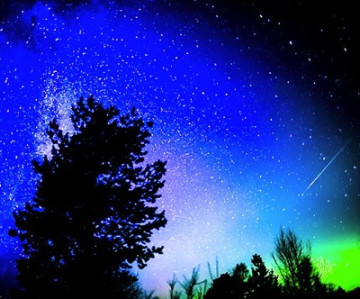October’s Orionids Bring Meteor Showers To Rhode Island
Saturday, October 12, 2013
October is a month with a variety of interesting astonomical events, including the Orionid meteor shower, a Full Hunter's Moon and a penumbral lunar eclipse.
Hunter's Moon + eclipse
The Full Hunter’s Moon occurs on October 18, but more importantly that evening we will be treated to a penumbral lunar eclipse. For a lunar eclipse to occur the Sun, Earth and Moon must be nearly in a straight line with the Earth in the middle of this alignment. The reason why lunar eclipses do not occur monthly is because the Moon usually passes north or south of the Earth’s shadow in space.
Unfortunately we will not experience a partial or total lunar eclipse because the Moon will not move into the Earth’s darker umbral shadow. Instead, the Moon will slide into a pale portion of the shadow called the penumbra. You will need to watch it closely and carefully. Many people will not notice anything different about the Moon unless they have followed the eclipse's progress throughout the evening.
GET THE LATEST BREAKING NEWS HERE -- SIGN UP FOR GOLOCAL FREE DAILY EBLASTThough the eclipse will begin at 5:50pm (first contact), this event cannot be seen. The Moon is only then beginning to slip into the dim penumbral shadow. Besides, it will have just risen at 5:47pm and will be close to the horizon. Only as the eclipse progresses will an observer see a slight darkening of the lunar surface as the Earth's penumbral shadow sweeps across it from south (bottom) to north (top). Mid-eclipse, or maximum, will occur at 7:50pm when 76% of the lunar disk will be within the penumbral shadow. At that time an informed observer should notice the subtle shading of the southern portion of the moon. The northern 24% will remain unchanged.
After mid-eclipse the Moon will begin to move out of the penumbral shadow and the lunar surface will brighten from north to south, returning the Moon to its normal brightness at 9:49pm. This event, like first contact, will be unobservable. (The next total lunar eclipse visible from southern New England will occur in 2014 on April 15.)
Orionids over Rhode Island
Three days later on the evening of October 21st to the early morning of the 22nd the annual Orionid meteor shower will grace our skies. Unfortunately the still bright waning gibbous Moon will
interfere with observing the peak rate of 20 or so yellow and green meteors per hour. However, the Orionids are also noted for producing fireballs that create persistent dust trains high in the atmosphere, so it might still deserve a few hours of your time if clear skies prevail.The meteors appear to radiate out of the sky just above Orion’s head (hence the name of the shower) and not far from the bright red super giant star Betelgeuse, which marks his right shoulder. While Orion is an easy star pattern to identify, at 3:30am this giant constellation will be due south of your location and about halfway up above the horizon. That pesky Moon, nestled among the V-shaped Hyades cluster of stars in Taurus, will be very close to the shower’s radiant point. Try to block the Moon from your vision to maximize your meteor count.
The best activity should occur between midnight and dawn. The particles we will see disintegrating in our atmosphere at around 41.6 miles per second are the remnants of Halley’s Comet.
Skyscraper's Special Moon event October 12th
Please join members of Skyscrapers, Inc. at Seagrave Memorial Observatory, 47 Peeptaod Road in North Scituate, Rhode Island, on Saturday, October 12, from 7-10pm, as we celebrate the 4th Annual “International Observe the Moon Night.”
Not only will the society’s main telescopes be focused on the first quarter Moon, but also our members will provide great views of our desolate neighbor through their personal instruments as well.
If you haven’t observed the Moon with great optics and a steady mount before, then this evening of lunar observing will certainly take your breath away. The first quarter phase is an ideal time to see a lot of detail on the Moon’s surface, especially near the terminator (the “line” that delineates the sunlit moonscape from the unlit portion). At that time, if you were standing anywhere along the terminator, the sun would be rising. This scenario creates long shadows, thereby revealing much crater and lunar mountain details.
One phenomenon to especially look for occurs near the terminator. Mountain tops and crater rims will catch the first rays of sunlight, while the landscape surrounding them will remain in darkness.
Please visit the Skyscrapers website (www.theskyscrapers.org) for further information. This special observing program is free and will be held weather permitting.
If you’d like to prepare yourself for this viewing experience, you can read two articles up on the Skyscrapers website. One explains the reason for the phases of the moon, and another describes lunar features that are prominent during the first quarter phase.
Hope you can join Skyscrapers as we celebrate this year’s “International Observe the Moon” event.
Wishing you clear skies for all your astronomical endeavors.
Related Articles
- Meteor Showers + More Predictions for 2012
- October Meteor Showers
- April Meteor Showers
- Meteor Showers This Weekend
- Perseid Meteor Shower Peaks in August
- April Meteor Showers + More
- Meteor Showers, Comets + More Predictions for 2013
- Rhode Island’s Biggest Meteor Shower of the Year Continues Tonight
- Best Meteor Shower of the Year Coming in December
- NEW: Peak Times to Watch Tonight’s Meteor Shower
- December Meteors Are Coming
- NEW: Perseid Meteor Shower Starts Tonight
- Exclusive: Local Chief Meteorologist Leaving TV Station
- New England Meteorologists’ Blizzard Forecasts—Who Will Be Right?
- July Meteor Showers + More Astronomical Events
- November Meteor Showers
- Meteor Shower Tonight
- October Meteor Shower Update



